Related Research Articles

A cathode-ray tube (CRT) is a vacuum tube containing one or more electron guns, which emit electron beams that are manipulated to display images on a phosphorescent screen. The images may represent electrical waveforms (oscilloscope), pictures, radar targets, or other phenomena. A CRT on a television set is commonly called a picture tube. CRTs have also been used as memory devices, in which case the screen is not intended to be visible to an observer. The term cathode ray was used to describe electron beams when they were first discovered, before it was understood that what was emitted from the cathode was a beam of electrons.
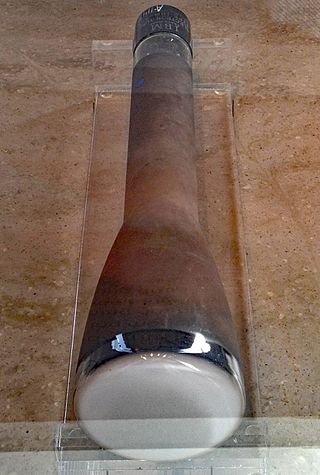
The Williams tube, or the Williams–Kilburn tube named after inventors Freddie Williams and Tom Kilburn, is an early form of computer memory. It was the first random-access digital storage device, and was used successfully in several early computers.
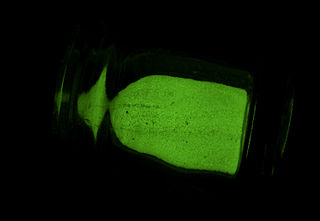
A phosphor is a substance that exhibits the phenomenon of luminescence; it emits light when exposed to some type of radiant energy. The term is used both for fluorescent or phosphorescent substances which glow on exposure to ultraviolet or visible light, and cathodoluminescent substances which glow when struck by an electron beam in a cathode-ray tube.
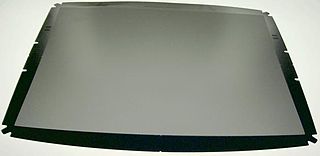
The shadow mask is one of the two technologies used in the manufacture of cathode-ray tube (CRT) televisions and computer monitors which produce clear, focused color images. The other approach is the aperture grille, better known by its trade name, Trinitron. All early color televisions and the majority of CRT computer monitors used shadow mask technology. Both of these technologies are largely obsolete, having been increasingly replaced since the 1990s by the liquid-crystal display (LCD).

A plasma display panel (PDP) is a type of flat panel display that uses small cells containing plasma: ionized gas that responds to electric fields. Plasma televisions were the first large flat panel displays to be released to the public.

The Selectron was an early form of digital computer memory developed by Jan A. Rajchman and his group at the Radio Corporation of America (RCA) under the direction of Vladimir K. Zworykin. It was a vacuum tube that stored digital data as electrostatic charges using technology similar to the Williams tube storage device. The team was never able to produce a commercially viable form of Selectron before magnetic-core memory became almost universal.

An LCD projector is a type of video projector for displaying video, images or computer data on a screen or other flat surface. It is a modern equivalent of the slide projector or overhead projector. To display images, LCD projectors typically send light from a metal-halide lamp through a prism or series of dichroic filters that separates light to three polysilicon panels – one each for the red, green and blue components of the video signal. As polarized light passes through the panels, individual pixels can be opened to allow light to pass or closed to block the light. The combination of open and closed pixels can produce a wide range of colors and shades in the projected image.
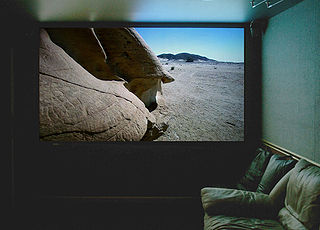
A video projector is an image projector that receives a video signal and projects the corresponding image on a projection screen using a lens system. Video projectors use a very bright ultra-high-performance lamp, Xenon arc lamp, LED or solid state blue, RB, RGB or remote fiber optic RGB lasers to provide the illumination required to project the image, and most modern ones can correct any curves, blurriness, and other inconsistencies through manual settings. If a blue laser is used, a phosphor wheel is used to turn blue light into white light, which is also the case with white LEDs. A wheel is used in order to prolong the lifespan of the phosphor, as it is degraded by the heat generated by the laser diode. Remote fiber optic RGB laser racks can be placed far away from the projector, and several racks can be housed in a single, central room. Each projector can use up to two racks, and several monochrome lasers are mounted on each rack, the light of which is mixed and transmitted to the projector booth using optical fibers. Projectors using RB lasers use a blue laser with a phosphor wheel in conjunction with a conventional solid state red laser.
Flicker is a visible change in brightness between cycles displayed on video displays. It applies to the refresh interval on cathode ray tube (CRT) televisions and computer monitors, as well as plasma computer displays and televisions.

A television set or television receiver, more commonly called the television, TV, TV set, telly, tele, or tube, is a large device that combines a tuner, display, and loudspeakers, for the purpose of viewing and hearing television broadcasts, or as a computer monitor. Introduced in the late 1920s in mechanical form, television sets became a popular consumer product after World War II in electronic form, using cathode ray tube (CRT) technology. The addition of color to broadcast television after 1953 further increased the popularity of television sets in the 1960s, and an outdoor antenna became a common feature of suburban homes. The ubiquitous television set became the display device for the first recorded media for consumer use in the 1970s, such as Betamax, VHS; these were later succeeded by DVD. It has been used as a display device since the first generation of home computers and dedicated video game consoles in the 1980s. By the early 2010s, flat-panel television incorporating liquid-crystal display (LCD) technology, especially LED-backlit LCD technology, largely replaced CRT and other display technologies. Modern flat panel TVs are typically capable of high-definition display and can also play content from a USB device. Starting in the late 2010s, most flat panel TVs began to offer 4K and 8K resolutions.
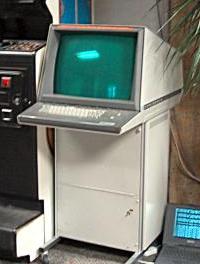
Storage tubes are a class of cathode-ray tubes (CRTs) that are designed to hold an image for a long period of time, typically as long as power is supplied to the tube.

Direct-view bistable storage tube (DVBST) was an acronym used by Tektronix to describe their line of storage tubes. These were cathode ray tubes (CRT) that stored information written to them using an analog technique inherent in the CRT and based upon the secondary emission of electrons from the phosphor screen itself. The resulting image was visible in the continuously glowing patterns on the face of the CRT.

A CRT projector is a video projector that uses a small, high-brightness cathode ray tube (CRT) as the image generating element. The image is then focused and enlarged onto a screen using a lens kept in front of the CRT face. The first color CRT projectors came out in the early 1950s. Most modern CRT projectors are color and have three separate CRTs, and their own lenses to achieve color images. The red, green and blue portions of the incoming video signal are processed and sent to the respective CRTs whose images are focused by their lenses to achieve the overall picture on the screen. Various designs have made it to production, including the "direct" CRT-lens design, and the Schmidt CRT, which employed a phosphor screen that illuminates a perforated spherical mirror, all within an evacuated cathode ray tube.
Digistar is the first computer graphics-based planetarium projection and content system. It was designed by Evans & Sutherland and released in 1983. The technology originally focused on accurate and high quality display of stars, including for the first time showing stars from points of view other than Earth's surface, travelling through the stars, and accurately showing celestial bodies from different times in the past and future. Beginning with the Digistar 3 the system now projects full-dome video.

Large-screen television technology developed rapidly in the late 1990s and 2000s. Prior to the development of thin-screen technologies, rear-projection television was standard for larger displays, and jumbotron, a non-projection video display technology, was used at stadiums and concerts. Various thin-screen technologies are being developed, but only liquid crystal display (LCD), plasma display (PDP) and Digital Light Processing (DLP) have been publicly released. Recent technologies like organic light-emitting diode (OLED) as well as not-yet-released technologies like surface-conduction electron-emitter display (SED) or field emission display (FED) are in development to replace earlier flat-screen technologies in picture quality.

Rear-projection television (RPTV) is a type of large-screen television display technology. Until approximately 2006, most of the relatively affordable consumer large screen TVs up to 100 in (250 cm) used rear-projection technology. A variation is a video projector, using similar technology, which projects onto a screen.

The 7JP4 is an early black and white or monochrome cathode ray tube. It was a popular type used in late 1940s low cost and small table model televisions. The 7JP4 has a 7" diameter round screen which was often partially masked. Unlike later electromagnetically deflected TV tubes, the 7JP4 is electrostatically deflected like an oscilloscope tube.
Electrically operated display devices have developed from electromechanical systems for display of text, up to all-electronic devices capable of full-motion 3D color graphic displays. Electromagnetic devices, using a solenoid coil to control a visible flag or flap, were the earliest type, and were used for text displays such as stock market prices and arrival/departure display times. The cathode ray tube was the workhorse of text and video display technology for several decades until being displaced by plasma, liquid crystal (LCD), and solid-state devices such as thin-film transistors (TFTs), LEDs and OLEDs. With the advent of metal–oxide–semiconductor field-effect transistors (MOSFETs), integrated circuit (IC) chips, microprocessors, and microelectronic devices, many more individual picture elements ("pixels") could be incorporated into one display device, allowing graphic displays and video.
A scotophor is a material showing reversible darkening and bleaching when subjected to certain types of radiation. The name means dark bearer, in contrast to phosphor, which means light bearer. Scotophors show tenebrescence and darken when subjected to an intense radiation such as sunlight. Minerals showing such behavior include hackmanite sodalite, spodumene and tugtupite. Some pure alkali halides also show such behavior.
Gustav Wikkenhauser (1901–1974) was a Hungarian engineer, naturalized as a British citizen in 1941.
References
Citations
- 1 2 Wikkenhauser 1948, p. 20.
- ↑ UK 513776,Rosenthal, Adolph H.,"Improvements in or relating to television receivers",issued 1938-02-03
- ↑ Kingsley 2016, p. 125.
- ↑ Rosenthal 1940.
- ↑ King 1946.
- ↑ King & Gittins 1946.
- ↑
 The dictionary definition of cathodochromism at Wiktionary
The dictionary definition of cathodochromism at Wiktionary - ↑ Leverenz 1946.
- ↑ King 1946, p. 171.
- ↑ Wikkenhauser 1948, p. 21.
- ↑ Wikkenhauser 1948, p. 22.
- ↑ Waltz 1948, p. 113.
- ↑ Adams, D.C. (2006). "The Kelvin-Hughes Photographic Display Unit (PDU)". Ventnor Radar. Retrieved 21 May 2017.
Bibliography
- "The Skiatron". Radar Recollections.
- King, P. (January 1946). "The Skiatron or Dark Trace Tube". Journal of the Institution of Electrical Engineers - Part IIIA: Radiolocation. 93 (1): 171–172. doi:10.1049/ji-3a-1.1946.0045.
- King, P.; Gittins, J. (May 1946). "The Skiatron or Dark Trace Tube". Journal of the Institution of Electrical Engineers - Part IIIA: Radiolocation. 93 (5): 822–831. doi:10.1049/ji-3a-1.1946.0175.
- Kingsley, F.A. (27 July 2016). The Development of Radar Equipments for the Royal Navy, 1935–45. Springer. ISBN 978-1-349-13457-1.
- Leverenz, H. W. (1946). "Luminescence and tenebrescence as applied in radar" (PDF). RCA Review. 7: 199–239.
- Rosenthal, A.H. (1940). "The Skiatron - a new Scophony development towards large screen television projection" (PDF). Electronics and Television & Short- Wave World: 74–81.
- Wikkenhauser, G. (January 1948). "The Skiatron or Dark Trace Tube and its Applications" (PDF). Electronic Engineering: 20–22.
- Waltz, George Jr. (July 1948). "Theater Vision". Popular Science. pp. 109–113.
- "4AP10 Skiatron data sheet" (PDF). RCA. 3 November 1944.
- "16ЛМ4Г Скиатрон data sheet" (PDF) (in Russian). Moscow Electric Lamp Plant (МЭЛЗ/MELZ).